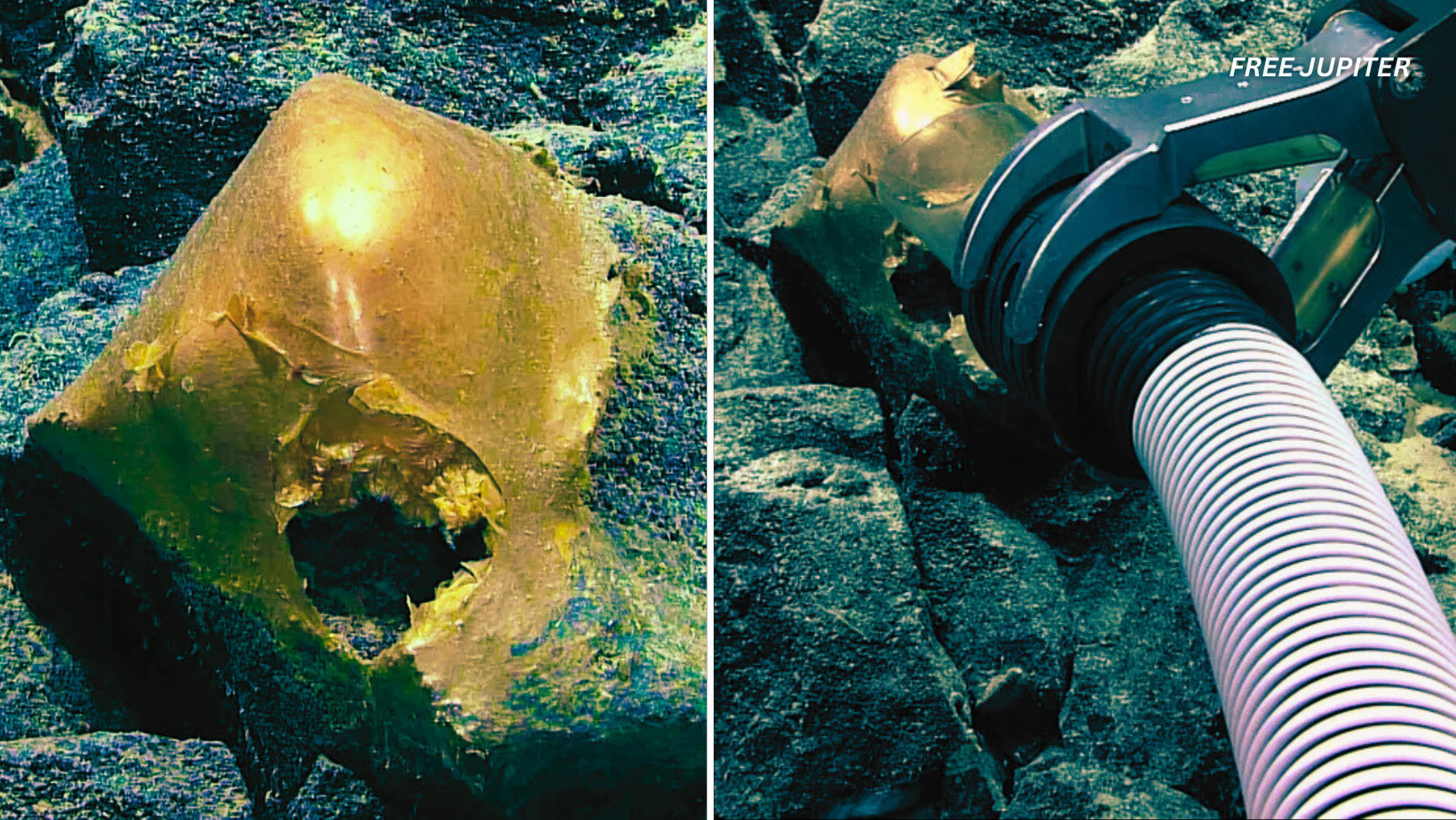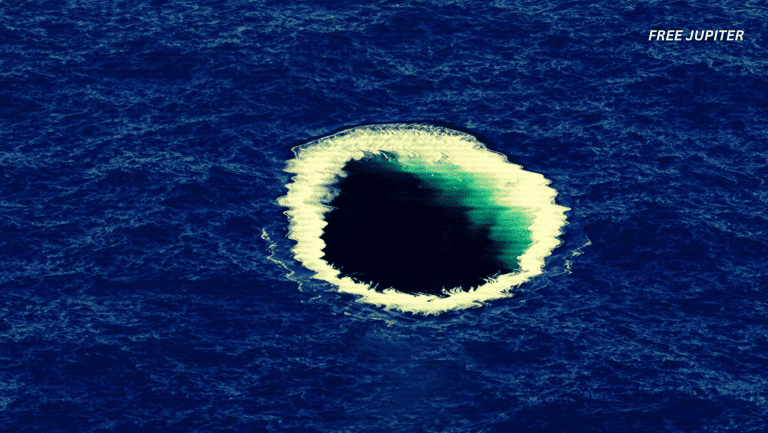Beneath the frigid, lightless depths of the ocean, an extraordinary discovery was made. At approximately 3,300 meters (2 miles) below the surface, off the coast of Alaska, a remotely operated vehicle from NOAA Ocean Exploration encountered something truly baffling—a golden-hued, spherical object resting on the seafloor.
This peculiar find, observed during an expedition in 2023, was affixed firmly to a rock surrounded by clusters of white sponges. Measuring around 10 centimeters (4 inches) in diameter, the object featured a single hole, leading to speculation about what may have emerged—or attempted to enter.
A Puzzling Deep-Sea Mystery
The identity of the golden orb remains uncertain, leaving researchers both fascinated and perplexed. Various theories were proposed as they observed the object in real time during the expedition. Some hypothesized that it could be an egg casing from an undiscovered species, while others speculated it might be a dead sponge or a type of coral.
The live-streamed discovery sparked an animated discussion among scientists. One openly admitted, “I have no idea what this could be.” Another pointed to the hole, suggesting, “It looks like something either broke out or burrowed in.”
Adding an eerie element to the discovery, a researcher lightheartedly remarked, “I just hope when we touch it, nothing creepy comes crawling out. This feels like the start of a horror movie.“
The notion that it could be an egg raised even more questions. If it once contained a developing organism, what kind of creature had emerged from it? If something had broken in, what might have preyed upon its contents? The object’s size further complicated matters—at 10 centimeters across, it was far larger than typical fish eggs, leading to speculation about an entirely new species or an unknown reproductive strategy.
Another point of intrigue was its appearance. Unlike many marine eggs, which tend to be translucent or gel-like, this object had an opaque, golden hue. Its texture, as later confirmed, was soft and fleshy, suggesting biological origin. Yet, it lacked the obvious structure of known marine organisms, leaving experts at a loss.
Adding to the mystery was its solitary nature. Most marine species that lay eggs do so in clusters or protective environments, but this orb was found alone, tightly adhered to a rock. This unusual placement raised questions about whether it was a naturally occurring phenomenon or if it had been deposited in a specific manner.
The mystery deepened further when preliminary tests aboard the research vessel failed to classify the object into any known category. Researchers knew they had stumbled upon something significant, but whether it was a newly identified species, a rare biological anomaly, or something entirely unexpected remained uncertain.
Read more: Scientists Are Investigating Puzzling Underground ‘Anomaly’ Near the Giza Pyramids
Examining the Unusual Object
Upon closer inspection, the orb’s texture provided additional clues. Deep-sea ecologist Kerry Howell of the University of Plymouth in the UK noted, “It has a soft, fleshy feel. There’s no distinct anatomy visible. Given the hole, it suggests some form of activity—either an entrance or an exit.”
If indeed an egg, the next question became even more compelling: what kind of creature could have produced it? Howell emphasized, “This isn’t the size of a typical fish egg. It’s much larger. Whatever laid it must be an unusual species.”
A robotic arm was used to cautiously interact with the orb. A gentle nudge confirmed its softness, prompting the team to extract it using suction for further study. Once aboard the research vessel, scientists conducted an initial examination under controlled conditions. The material composition suggested it was organic, yet it lacked identifiable structures such as veins, scales, or skeletal features.
Advanced imaging techniques were employed to analyze its inner layers. Scans revealed a uniform density, ruling out the presence of a developing embryo or any obvious signs of life within. However, microbial testing indicated traces of unknown biological material, further deepening the mystery. Genetic sequencing is expected to provide additional insights, but as of now, its classification remains elusive.
Specimens like these often provide crucial information about the deep-sea ecosystem, potentially revealing new species or previously unknown reproductive behaviors. Scientists hope that by studying its molecular structure, a clearer picture will emerge regarding its origins and purpose.
Read more: Scientists Discover That Most Europeans Had Dark Skin As Recently As 3,000 Years Ago
Why Was It Found Alone?
Another intriguing aspect was its solitary nature. In most cases, creatures that lay eggs do so in clusters or protected environments. The isolated placement of this object suggests an anomaly in known reproductive behaviors of deep-sea species. If it is indeed an egg, it presents an opportunity to understand marine life in greater depth.
The deep ocean, with its extreme cold, crushing pressure, and perpetual darkness, remains one of the least explored frontiers on Earth. As technology advances, remotely operated vehicles continue to unveil its many secrets, including the potential reproductive habits of its elusive inhabitants.
Unlocking the Ocean’s Hidden Wonders
Sam Candio, an exploration coordinator at NOAA Ocean Exploration, summed up the excitement and uncertainty surrounding the discovery. “The deep sea never ceases to amaze us. It’s a reminder of how little we truly understand about our own planet.”
Although the mysterious golden orb has been successfully retrieved and analyzed aboard the research vessel, its exact nature remains undetermined. What is known for certain is that it is of biological origin—beyond that, much remains a mystery.
Candio acknowledged the humbling experience of encountering something completely unknown. “Findings like these remind us of how much is left to explore and appreciate about our oceans. There are still countless species and phenomena waiting to be discovered beneath the waves.”
Read more: Rabbit Hole in Farmer’s Field Leads To ‘Mystery Caves’ Used By The Knights Templar
The Endless Mysteries of the Deep
This discovery serves as yet another testament to the ocean’s ability to surprise, intrigue, and challenge scientific understanding. Whether the golden orb turns out to be an egg, a new species, or something entirely unexpected, it reinforces the need for continued exploration of the deep sea. With each new revelation, a better understanding of our planet’s most mysterious realm unfolds.
For now, the enigmatic golden sphere remains an unsolved puzzle—a shining beacon of the unknown in the vast, uncharted depths of the ocean.










